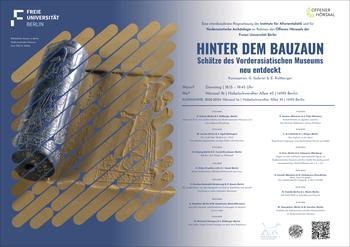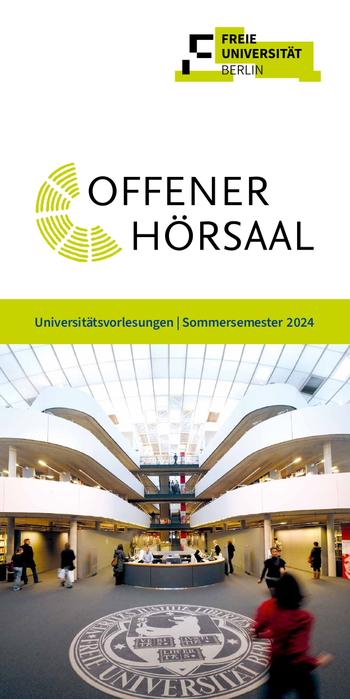Offener Hörsaaal SoSe 2024: "Hinter dem Bauzaun. Schätze des Vorderasiatischen Museums"
Tuesdays, 6-8 p.m., program online, presence and live stream.
News from Apr 19, 2024
„Hinter dem Bauzaun. Schätze des Vorderasiatischen Museums neu entdeckt“, conceived and organized by the Institutes for Ancient Near Eastern Studies (PD Dr. Gösta Gabriel) and Near Eastern Archeology (Prof. Dr. Elisa Roßberger). Every week, an object or a group of objects from the Near Eastern Museum, which was closed for renovation for many years, is presented by two experts from different professional perspectives.
The lecture series: "Hinter dem Bauzaun. Schätze des Vorderasiatischen Museums neu entdeckt" will take place in the summer semester of 2024, on Tuesdays from April 23rd, 2024, 6-8 p.m., in lecture hall 1b of the FU Berlin, building complex Habelschwerdter Allee 45, 14195 Berlin. Exception: On Tuesday, June 18, 2024, the event will take place in lecture hall 1a (FU Berlin, building complex Habelschwerdter Allee 45, 14195 Berlin).
Alternatively, there is the option of joining in online via a livestream.
You can find out everything else here.
The poster and the complete brochure of the FU lecture series: "Hinter dem Bauzaun. Schätze des Vorderasiatischen Museum neu entdeckt" can be opened at the bottom of this website under "Links zum Thema”.
The Near Eastern Museum has been closed since October 23rd last year. There will probably not be a reunion with Ishtar Gate and Co. before 2037. This means, for example, that the children who started school last fall will already have completed their schooling. But a closed museum does not mean that its treasures will disappear. The research continues. A large research network in Berlin deals with evidence from the ancient Near East. This network includes, among other things: the Freie Universität Berlin, the German Archaeological Institute and of course the Near Eastern Museum itself. There are also numerous national and international collaborations. The lecture series makes selected museum treasures that have now disappeared behind the scaffolding visible. These include famous highlights such as the Ishtar Gate from Babylon, but also seemingly inconspicuous objects such as a broken clay tablet, fragments of ivory or a clay brick. Every week, two speakers present an object or a group of objects from the museum's collection from different professional perspectives. When brought to speak in this way, the collection objects open up insights into the breadth and diversity of past worlds: they tell of the first metropolises, of religious practices on a large and small scale, of everyday life and rulers' ideologies, of ancient myths and astronomical calculations, of beauty and decay. At the same time, the lecture conveys the spectrum of research into ancient remains. Archeology and scientific analysis, restoration work, historical and stylistic classification, research on languages and scripts, as well as digital methods and AI-supported processes are used.

